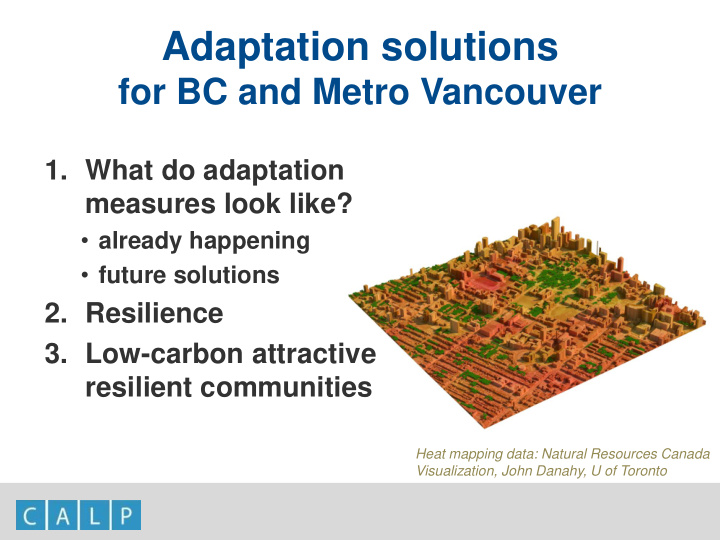



Adaptation solutions for BC and Metro Vancouver 1. What do adaptation measures look like? • already happening • future solutions 2. Resilience 3. Low-carbon attractive resilient communities Heat mapping data: Natural Resources Canada Visualization, John Danahy, U of Toronto
Adaptation • Technological Solutions: – Better insulated buildings to higher – Reflective roads/walls – Built in cooling systems (not AC!) temperatures • Administrative Solutions – Weather warning systems – Encourage tree planting – Heat-waves plan for vulnerable • Personal Behavioural Solutions – Maintain hydration – Wear less formal clothing – Change working hours – Enjoy it! Courtesy of Chris West, UKCIP
Kimberley: Fire, flooding, and heat risks Risk of debris flooding Increase through MPB desease Climate Change: Increase of winter precipitation Visualization: Olaf Schroth/Courtney Miller, CALP
Adaptation and Mitigation: Resilient low-carbon Kimberley Climate Adaptation Project June 9, 2009 Community Open House Visualization Presentation Image credit: Miller/Muir Owen/Pond/CALP options
Adapting to What? NORTHSHORE VULNERABILITY TO CLIMATE CHANGE • High elevations, steep slopes • Sensitive recreation and water resources • High rainfall • Extensive forest areas • Fragile salmon habitat/riparian ecosystems • Critical stream flows and high run-off • Low-lying shoreline areas
Recognizing Local Adaptation
Stormwater swale, 15 th Street, West Vancouver ADAPTATION SOLUTIONS
West Vancouver’s climate change planning: • Beach adaptation (& ocean heat exchange) Photos: Stephen Jenkins, District of West Vancouver
Current Visualizations: David Flanders, CALP
2050
2100 2100
2100
How to Adapt? Assessing 3 scenarios: Hold the Line Managed Retreat Build Up Delta Regional Adaptation Collaborative (RAC) Policy Report (Barron et al., 2012)
Hold the line – 1.2m
Hold the line – 1.9m
Build Up Value of Land & Buildings Agricultural Land Area Road & Dike Length Ladner Dike View 1.2 m Sea Level Rise, Year ~2100
Build Up
Resilience – ability to absorb disturbances while retaining the same basic structure and ways of functioning; capacity to adapt. Credit: Megan Voigt, UBC Landscape Architecture
Adaptation to crop suitability Source: Royal BC Museum/Richard Hebda
Online interactive maps of solar roof potential Developed by Professor Nicholas Coops and Rory Tooke, UBC for District of North Vancouver
Northshore storyline: a high-carbon, high-risk aesthetic Existing Grouse Mosquito Housing Mountain Creek High Risk of Blow Down Mod- High Forest Fuel Potential Visualizations: David Flanders, CALP Mosquito Creek
2050 Burnt Expansion of homes areas at higher elevations Kelowna, 2004
Renewable Energy Capacity Mapping Example: Northshore biomass and micro-hydro
High-carbon, nondescript, vulnerable communities Low-carbon, Attractive, Resilient Communities Visualizations: David Flanders, CALP
Lo-CAR sustainability: 1. Low-Carbon – 80% reductions of GHG emissions by 2050 – Hard target 2. Attractive/acceptable/ ‘ awesome ’ – Sense of identity, character/fit, and quality of life 3. Resilient – Adapt to climate disruption, high energy prices, etc., while maintaining core functions
Visualization: Jon Laurenz, CALP
60% reduction in Smaller, efficient Local food Community Multifamily home energy cars gardening market suites consumption Stormwater Live / work Passive solar drainage swale conservatory development Electric Increased public commuter transit vehicles
How much money do we want to spend to safeguard our community? Photo: Mark van Manen, Vancouver Sun
Resources: Delta RAC website: http://www.delta-adaptation-bc.ca Visualization Training Modules : http://www.delta-adaptation- bc.ca/category/training-modules/ Visioning Guidance Manual Earthscan/Routledge book (Pond et al, 2010) www.routledge.com/books/details/97818440782 www.calp.forestry.ubc.ca/publications 02/
THINK BIG! Daylighting the Cheong Gye Cheon in Seoul, South Korea . Courtesy of Dr. In-Keun Lee.
Recommend
More recommend